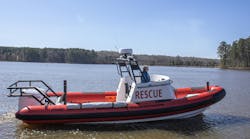With that little safety reminder, we will return to our a-frame to prepare for the move.
Bearing Points
- (2) Shovels (to dig holes)
- (2) Gusset plates, if ground is soft
- (2) Pinch bars
Dig a hole for each foot, about one to two inches bigger in each direction and as deep as the dimension of the lumber (4x4, dig down 5 to 6 inches, dig it 6x6). The feet should be inserted into these holes to create a pivot point for the gantry.
As lifting begins, the force in each of the gantry legs will be about equal to the load. Spotters must use pinch bars to help guide the feet into the bearing points and to help resist the lateral forces while the gantry moves into position. In soft ground, it may be necessary to use gusset plates (12-inch x 12-inch plywood) to spread the load at each foot.
Load Rig
The gantry structure being complete, the haul and belay lines rigged and the entire system in position, it is time to hook the load onto the lifting rig, insuring that the load will lift evenly and that the load will not engage until the gantry is over 45-degrees. Again, this is not a load rigging discussion, but consideration needs to take place regarding the position of the load and taking into account the load's center of gravity. When the load is lifted, it is important to insure that the load doesn't roll into a new position and throw off the weight distribution. Connect the lifting rig to the anchor sling of the gantry. As mentioned earlier, we have found that having a way to adjust the length between the anchor sling and the load sling makes the whole job a lot easier. A chain hoist or come-along works great in this situation. It's time to put this machine to work and move some stuff.
Moving The Load
Assign one person to oversee the operation and act as safety officer. This person should have a pinch bar or picket, the purpose of which we will discuss later. There should be one person stationed at each foot, also armed with pinch bars. One or more persons should be stationed at the belay device.
Finally, the balance of your personnel should be prepared to act as the haul team; one person should be on the running end of the entire haul system, the others should take up station at the apex of the gantry. The number of personnel required depends on the size of the load and the gantry, but we have done this plenty of times with six man teams.
With the assistance of the Haul Team at the apex, the "Foot Team" should move the gantry to guide the feet into the holes. The Haul Team should have a short 4x4 nearby. The reason for this 4x4 is that as the Team Leader orders the Haul Team to lift the apex toward the 45 degree position, the 4x4 can be placed vertically as a column under the apex to support the gantry if it has to be eased down, or if adjustments need to be made. As the gantry is lifted to 45 degrees, the lone haul team person on the rope should tension the line, taking care to insure the progress capture device is holding the gantry from going back to ground. The belay line should be slack.
The haul team should, on order of the Team Leader to lift, walk the gantry up until it is at 45 degrees, then someone has to take all of the slack out of the chain hoist (or whatever arrangement was made for adjusting the length between the anchor sling and the load sling). The haul line again should be maintaining as much of the gantry weight as possible. That being done, the haul team now should move (quickly) to the haul line and on order, haul the load.
The "Foot Team" has to make sure the feet stay in the holes with their pinch bars. Their job is to help keep the feet in the holes going up, resisting the outward thrust as the gantry rises toward a 90 degree angle, then resisting the reverse thrust when the load is being lowered. The Foot Team and the Team Leader should have their eyes on the load and the gantry at all times.
The load should slowly begin to rise and the Team Leader (get out your pinch bar) should arrest the tendency of the load to pendulum. I have seen an unchecked load swing up to knock out the ledger (in this case a ledger board) and kick both feet forward. Needless to say, it wasn't pretty.
Realize that an impact perpendicular to the long axis of the gantry legs could prove catastrophic. Again depending on the size of the load, the load is usually moving slowly enough (the Haul Team is on a 20:1 system after all) that simply planting the point of the pinch bar into the ground ahead of the load has often slowed the motion down.
The key for the belay team is to allow as much slack as possible while not letting the gantry get ahead of them for the descent back on the other side. As the gantry becomes closer to 80 or 90 degrees, the Team Leader should be notifying the belay team to begin slowing the movement of the gantry. The haul team should be pulling away at the command of the Team Leader, resetting as necessary. If you have the luxury of extra personnel station someone at the progress capture device.
As the load gets to 90 degrees, the team leader should continue to insure the load passes between the legs smoothly (this could also be accomplished with a tag line). As the load passes over the centerline, the haul team must stop hauling and the belayer needs to take up slack and slowly guide the load back down to 45-degrees on the other side, remembering all of our earlier discussion, especially in regard to the load's momentum and the rope's tendency to elongate.
As rope has some give, belaying the load is best acquired through practice or under the supervision of someone who has done this before. There is a certain amount of finesse involved in just allowing the line to become taut as it NEARS centerline (the momentum of the load will facilitate some initial rope stretch) and then, as the rope is stretched to maximum and is bearing the weight, allowing the load to go softly to ground.
Using the rope below 45-degrees in either direction will result in the load on the rope exceeding 130% of the load weight. Once the load is at 45-degrees again and the load is on the ground, have the haul team move up and assist the gantry in going to the ground by walking it back, again, like walking down a ground ladder. The 4x4 used earlier can be utilized here again as well to elevate the apex, making it easier to work.
Substitutions and Comments
I learned how to make an a-frame gantry for the first time in 1981; the text we used at that time was Dawson Nethercutt's International Manual of Basic Rescue Methods. Since then, we have done this a lot of different ways and I've seen it taught a lot of different ways. The point I'm trying to make is that we have outlined the basics and they require you to go play with them a little and challenge yourselves.
The concepts are sound; we are taking a heavy weight, lifting and moving that weight using a mechanical advantage, and distributing that weight to ground by way of columns, or in this case, the legs of the gantry. This year I presented this subject at the South Carolina Fire Academy's Rescue School 2003 and 64 students offered different suggestions and solutions.
My suggestion: take what you already know about lifting and rigging, use a heavy (but not dangerous) weight, consider this article, and practice. You may never use an a-frame gantry in a rescue situation, but the individual skills utilized and the teamwork required in putting it all together are something you can use on every single incident.
Two quick suggestions: A solution to avoid the congestion at the apex with all of those slings; First, use a chain sling instead of a multi-wrap anchor sling as the connection for the load at the apex. After all, if you use an adequately rated sling, what are you going to pick up that's going to break it? Furthermore, the chain is easier to spot with all of that rope around that point. Chain doesn't usually slip, and it generally simplifies the process. Finally, instead of making all of these anchor slings, terminate the haul and belay on the apex using tensionless wraps around the apex.
Hopefully this series has helped you understand how to set up and use an a-frame gantry as well as appreciate the physics involved in moving a large object with fairly basic and time-honored principles.
Related:








